ATTENTION! All pictures are presented in high resolution. To see Hi-Res images – just TWICE click on any picture. In other words, click small picture – opens the BIG picture. Click BIG picture – opens VERY BIG picture.
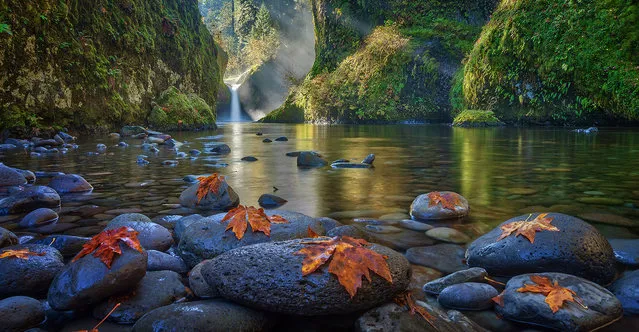
“Steamy Mornings”. Autumn sun pours into Punch Bowl Falls to create some stunning atmospherics. I didn't have long to capture the moving light beams so I frantically started shooting as soon as I arrived on the scene. Photo location: Columbia Rive Gorge, Oregon, USA. (Photo and caption by Gavin Hardcastle/National Geographic Photo Contest)
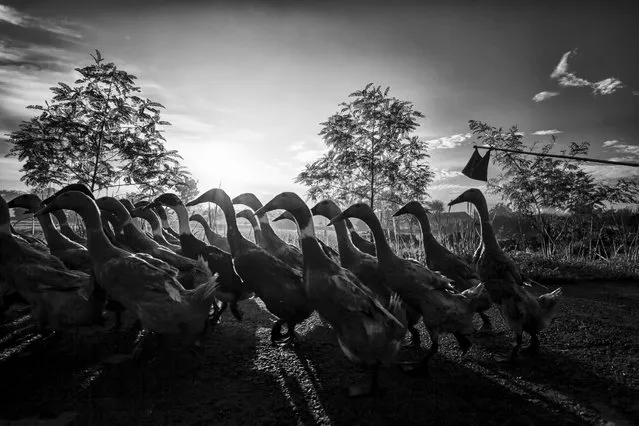
“Marching”. Indonesian farmer herds an army of ducks into rice field at dawn. Ducks are free to roam into rice field to remove insect and plant pests as they fertilize the young rice plants with their droppings. Photo location: Yogyakarta, Indonesia. (Photo and caption by Yew Kiat Soh/National Geographic Photo Contest)
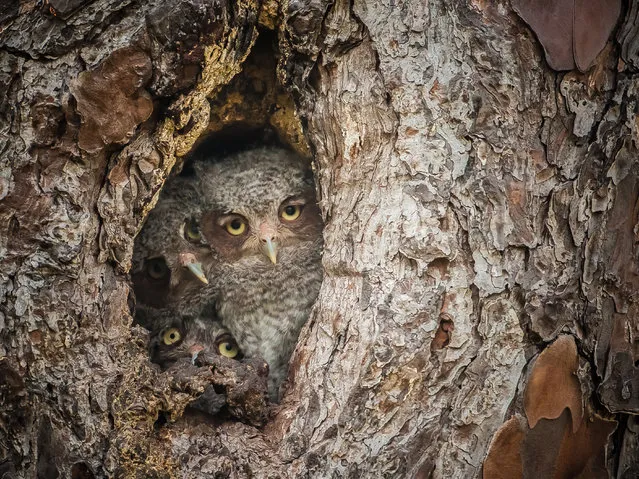
“Masters of Disguise, The Next Generation ”. Eastern Screech Owls like to take over woodpecker nests that have been dug out over the years in pine trees, which are the main species of tree at this swamp. Fish and wildlife also paint a white ring around the base of a tree that has active nests in order to avoid when conducting controlled burns. Screech owls can range in height anywhere from 8-10 inches, so you have to have a sharp eye to find these little birds of prey. I spent the first few weeks of April this year photographing the grey morph screech owl that was living in the nest, and had no idea there were three owlets inside. Photo location: Okefenokee Swamp, Georgia, USA. (Photo and caption by Graham McGeorge/National Geographic Photo Contest)
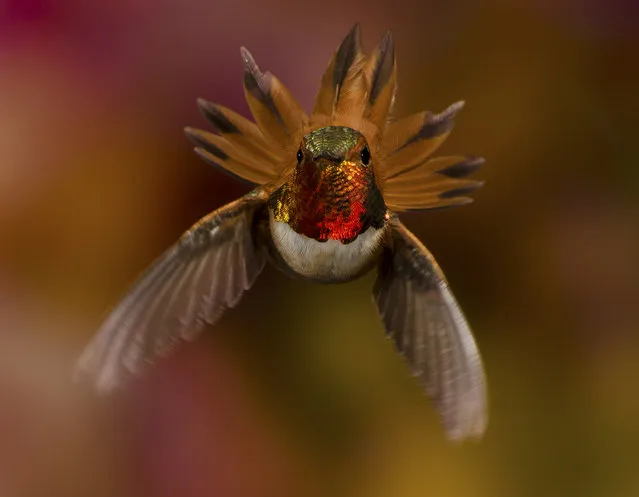
“I'm In Charge!” While photographing hummingbirds in British Columbia I shot this male Rufous just as he fanned out to show his authority when another male Rufous appeared over my head. Photo location: Cranbrook, British Columbia. (Photo and caption by Scott Bechtel/National Geographic Photo Contest)
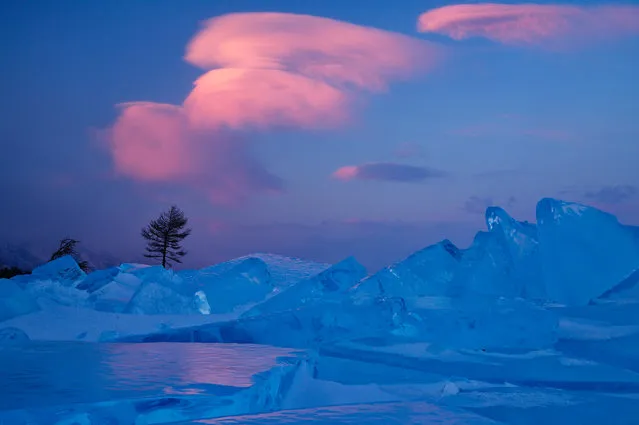
“Dreams of the lonely larch”. Russia, Baikal lake, cape Pokoyniki. The cape is one of the most interesting places at the shore of Baikal lake. “Pokoyniki” in Russian means “dead men”, the legend tells about Buryat settlement, suddenly died of unknown disease. Another name of this cape – Pokoyniy, means “quiet”, because of very quiet bay behind the cape. March, evening twilight, -20C. Photo location: Cape Pokoyniki, Baikal lake, Russia. (Photo and caption by Alexey Kharitonov/National Geographic Photo Contest)
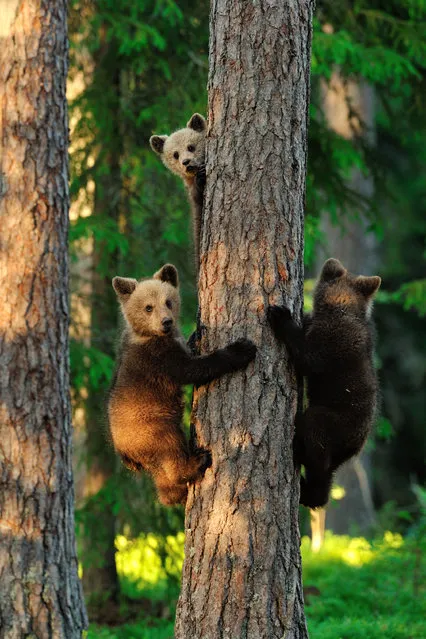
“Three little bears”. The picture is captured using special hide placed to the primeval forest in Finland. High trees offer protection to the brown bear cubs being vitally important to survive from all dangers around them. Bear cubs are threatened especially by the other male bears, who might attack and take their lives without any doubt. Thus fast climbing on tree is one of the most important skills for bear cubs in order to survive and they are always ready for it. Photo location: Finland, next to Russian border. (Photo and caption by Erik Mandre/National Geographic Photo Contest)
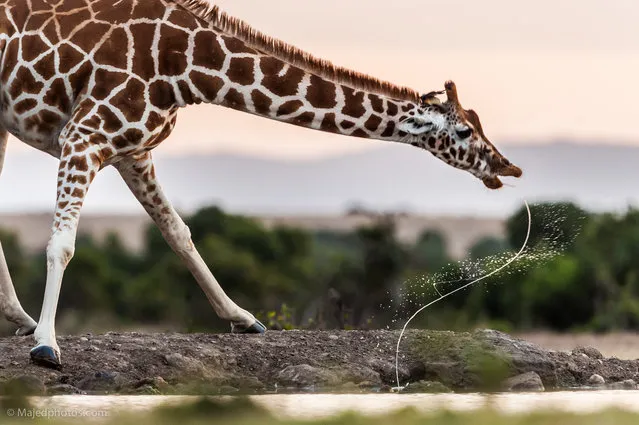
“Mara”. We just want to move to search to the Leopard at that morning but we found a group of giraffes come toward a small lake and start drinking it was a nice moment when the Giraffe finish from drinking and leave a letters “S” with motion in the air. Photo location: Kenya. (Photo and caption by Majed Al Zaabi/National Geographic Photo Contest)
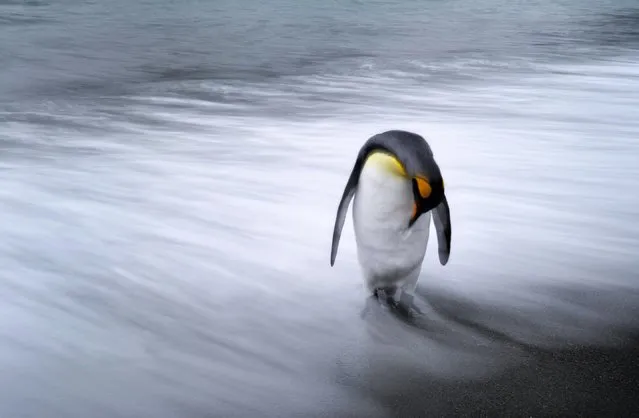
“Lone Penguin”. A long penguin standing in the surf on South Georgia Island. Photo location: South Georgia Island. (Photo and caption by Max Seigal/National Geographic Photo Contest)
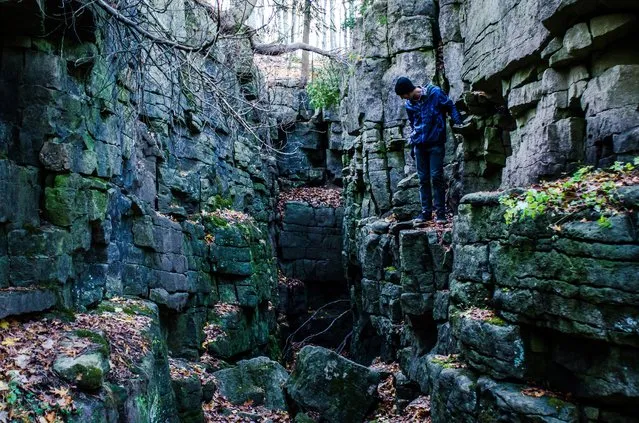
“Into the void”. Found this fissure while hiking with my brother one day, and scaled down into it and explore around. Photo location: Kelso Cliffs, Ontario, Canada. (Photo and caption by Dan Sedran/National Geographic Photo Contest)
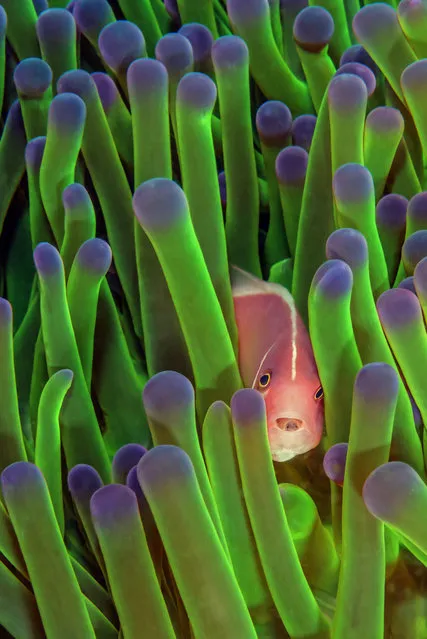
“Anomonefish with tongue parasite”. Rare photo of a tongue parasite in an Anemonefish, taken in Komodo, Indonesia. Photo location: Komodo, Indonesia. (Photo and caption by Peter Allinson/National Geographic Photo Contest)
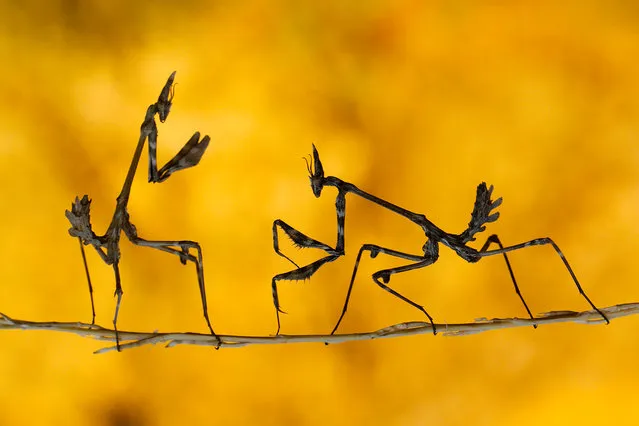
“Fight”. Kahramanmaras. Photo location: Kahramanmaras, Turkey. (Photo and caption by Mehmet Karaca/National Geographic Photo Contest)
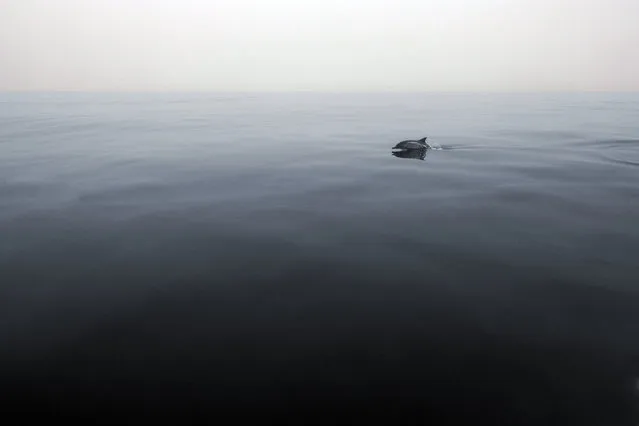
“The Guardian”. This solitary dolphin could not not been more beautiful when it rose out of the still ocean water. Photo location: Channel Islands, California, USA. (Photo and caption by Robin Benson/National Geographic Photo Contest)
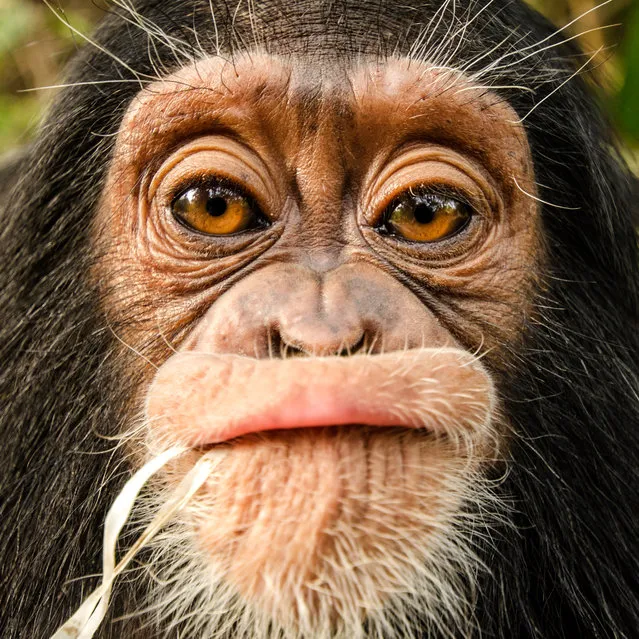
“Baby Girl”. Nyanga, an orphaned baby chimp from the bushmeat trade, is rehabilitated at the Sanaga-Yong Chimpanzee Rescue Center, Cameroon. Photo location: Belabo, Cameroon, Africa. (Photo and caption by Allison Leach/National Geographic Photo Contest)
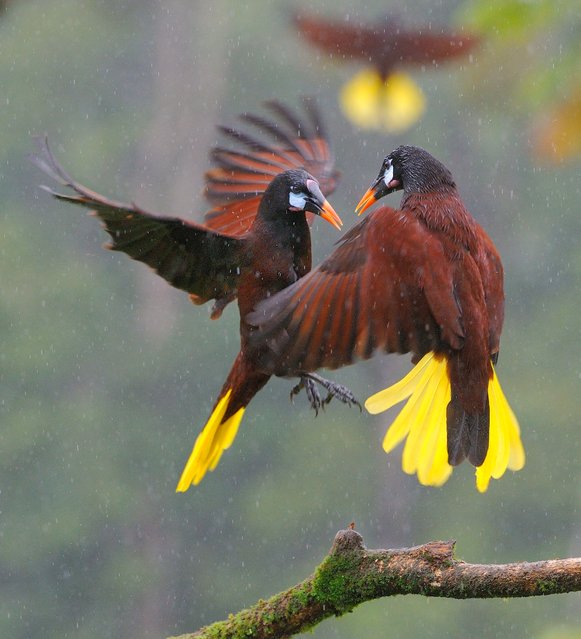
“Oropendola ruckus!” Montezuma Oropendolas squabbling over bananas in the rainforest. Photo location: Laguna del Lagarto, Costa Rica. (Photo and caption by Leslie Anderson/National Geographic Photo Contest)
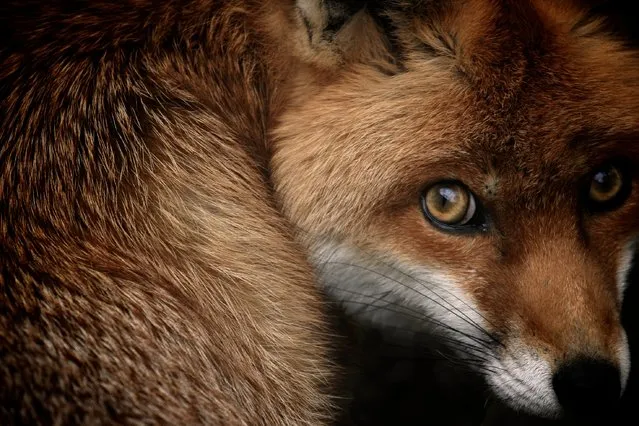
“Fox Glance”. During a regular trip through the forest, of which my actual intent was landscapes, I encountered this stunning little Red Fox. The moment came as the light broke through the clouds and trees, he turned with a glance of curiosity and gave me the unusual composition I was after. A scene I'll never be lucky enough to see again in my life, so was over the moon i'd managed to capture the moment. Photo location: Thetford Forest, England. (Photo and caption by Sam Morris/National Geographic Photo Contest)
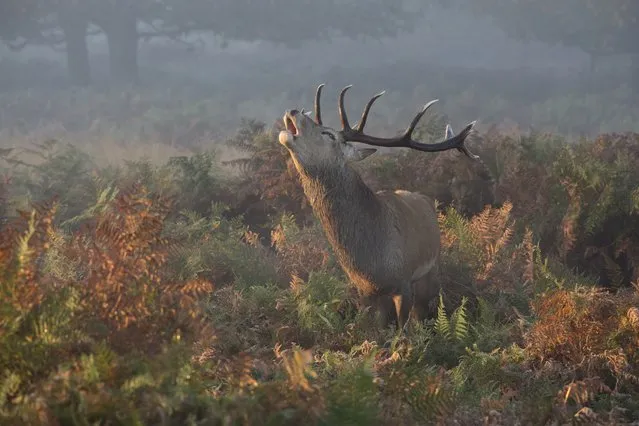
“Deer Calling”. This was taken early morning whilst at Richmond Park in Late October. Photo location: Richmond Park, London. (Photo and caption by Prashant Meswani/National Geographic Photo Contest)
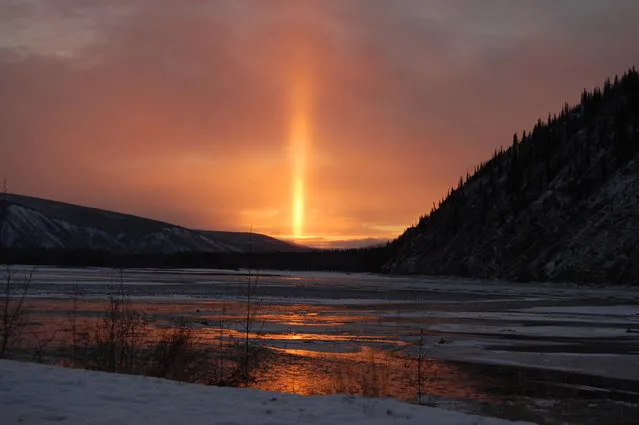
“Amazing Midwinter Sunset (4:30pm)”. November 6th, 2013 – at approximately 4:15 pm we were all watching this amazing batman like beam coming over the dyke on the upstream side of the Yukon River which was just beginning to freeze. I grabbed a camera, made my way over towards the river and discovered this amazing scene. As we are heading towards the shortest day of the year, the sun usually disappears between 4:30-4:45 pm. Photo location: Yukon River, Dawson City, Yukon Territory, Canada. (Photo and caption by Andrea Magee/National Geographic Photo Contest)
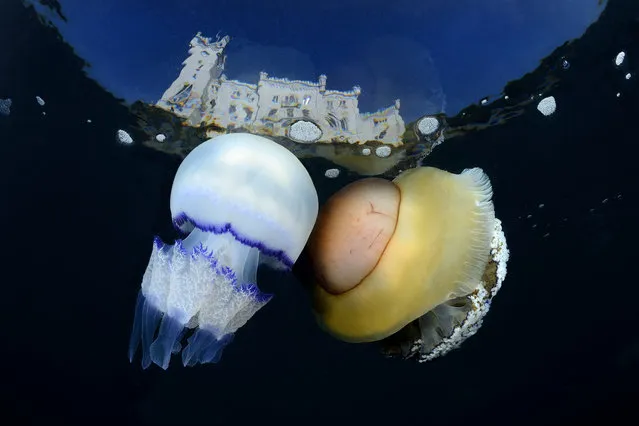
“Jellyfish kiss under the castle”. This summer there was a significant presence of this type of jellyfish (Rhyzostoma pulmo and Cothyloriza tuberculata) in the Adriatic Sea in front of Trieste where I live. So I immediately thought to photograph with the backdrop of Miramare Castle which is one of the most beautiful castles overlooking the sea in the world. I struggled to get two jellyfish in a favorable position close to the surface in order to obtain the image of the castle in transparency. I used my beloved Nikon D800E with the Sigma 15mm fisheye in Seacam housing with the Superdome and two flash Seacam 150. Photo location: Trieste, Italy, northern Adriatic Sea. (Photo and caption by Adriano Morettin/National Geographic Photo Contest)
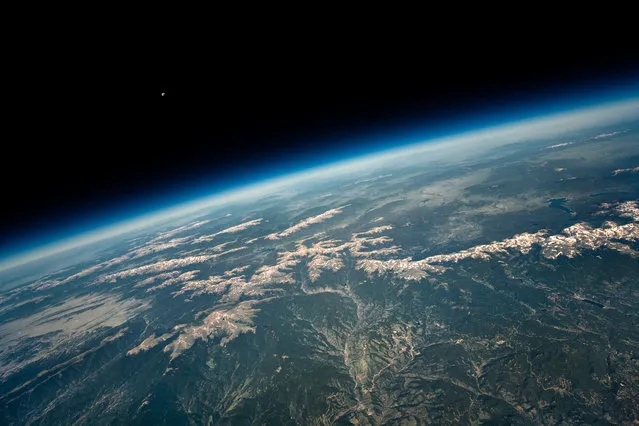
“Rocky Mountain High”. Snow-capped peaks of the Continental Divide stretch across the landscape west of Denver, Colorado. From 86,000 feet the Moon shines bright against the inky black of the stratosphere while in the foreground Interstate-70 carves its way up the valley toward high alpine passes and the famous ski resorts of Colorado. Photo location: Denver, Colorado. (Photo and caption by Patrick Cullis/National Geographic Photo Contest)
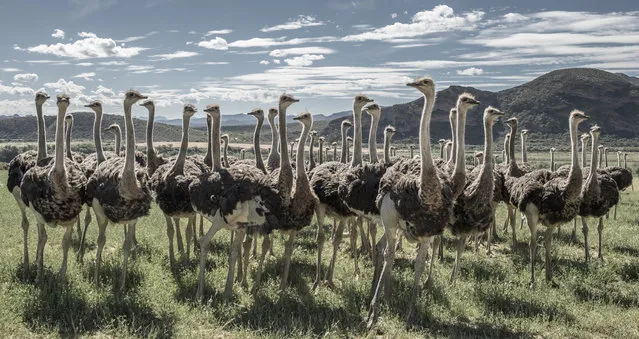
“The Ostrich Council”. While driving in the Little Karoo desert in South Africa, we came across a group of ostriches. Not thinking about photography yet, I noticed that each one of them started approaching me if I could stand perfectly still in the field. I thus switched to a 35mm lens, kneeled down and stopped moving for around 20min. Once the surrounding group was close and large enough, I could finally take the shot. The shutter noise and a little movement of my hand made them run away in an instant and concluded this very special moment. Photo location: Little Karoo desert, South Africa. (Photo and caption by Matthieu Moors/National Geographic Photo Contest)
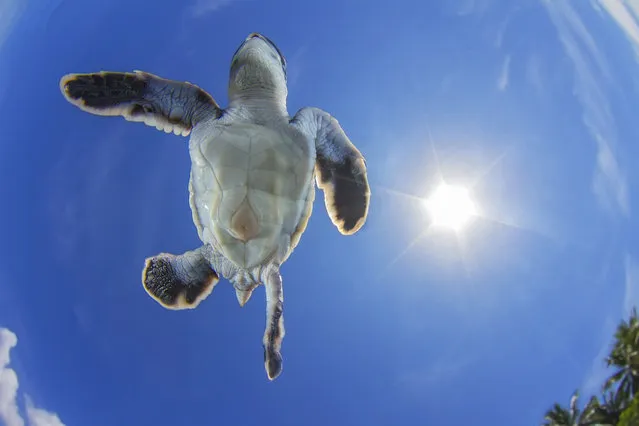
“Sky Swimmer”. I was looking a long time for the green sea turtle nest. After i was survey the birth day. I was staying in the water close to the beach, and many turtles came in the sea, trying to go the ocean. One of them came straight away on me and i put my camera lense just below the surface. Photo location: Tikehau island, tuamotu archipelago, French Polynesia. (Photo and caption by Vincent Truchet/National Geographic Photo Contest)
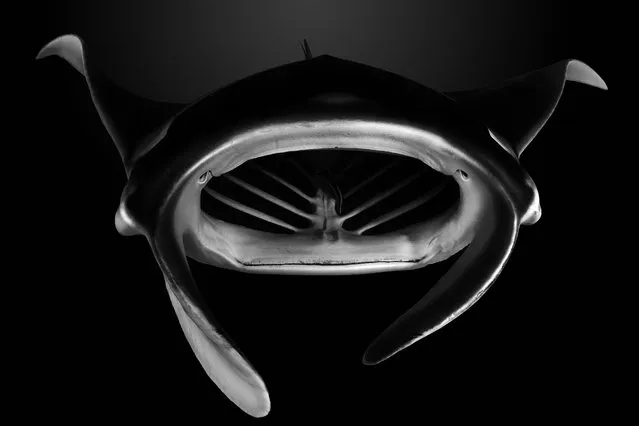
“Manta-Art”. An alfredi manta ray came close to me with her mouth open on a cleannig station area. Photo location: Tikehau island, tuamotu archipelago, French Polynesia. (Photo and caption by Vincent Truchet/National Geographic Photo Contest)
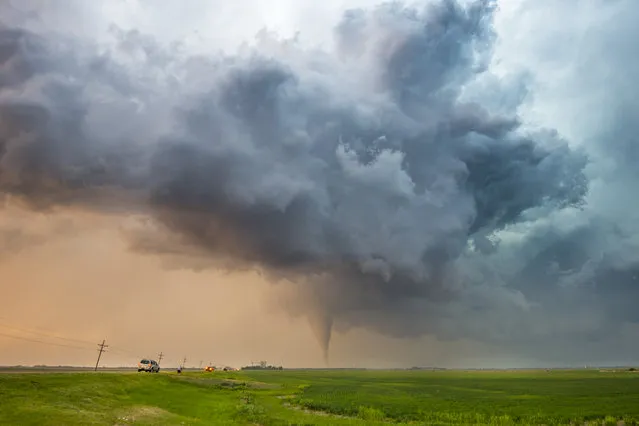
“The Sunsetter”. An EF-4 tornado rips through the open space of farmland near Rozel, Kansas. This tornado moves slowly but powerful towards the setting sun an gets its beautiful color right before sunset. Storm Chasers are spotting on the left side. Photo location: Rozel, Kansas. (Photo and caption by Dennis Oswald/National Geographic Photo Contest)
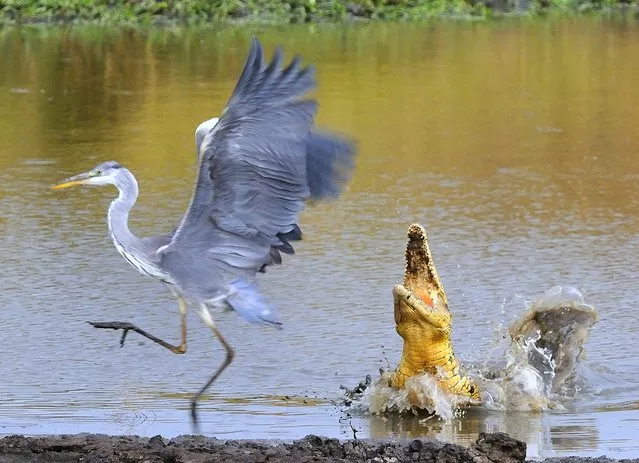
“Close call!” The Nile Crocodile made this a risky place for a Grey Heron to fish! Photo location: Masai Mara NP, Kenya. (Photo and caption by Leslie Anderson/National Geographic Photo Contest)
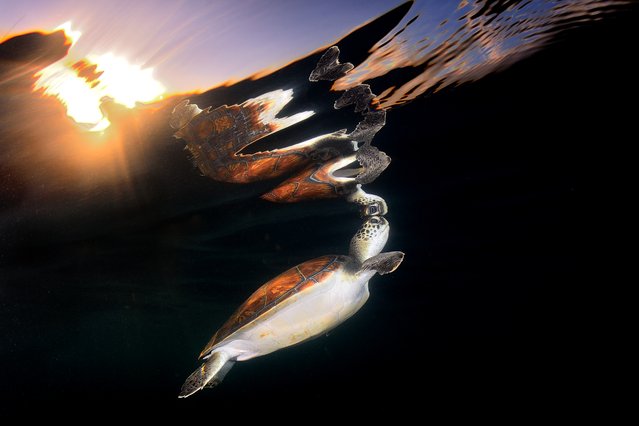
“Playing with himself”. Turtles come to the surface to breathe. It seems that he is playing with his own image. I was looking for a soft light at sunset, and a calm sea when the reflection was more visible. The exact moment when both sides are in contact was a magical vision for me. Photo location: Tenerife, Canary islands, Spain. (Photo and caption by Sergi Garcia/National Geographic Photo Contest)
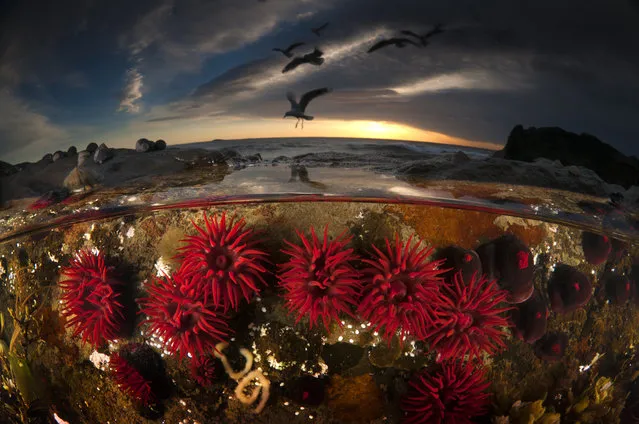
“Waratah Anemones”. An over/under water split level image of beautiful crimson red waratah anemones in a rock pool at low tide. What I really love about over/under photographs is that it gives the underwater element a sense of place. For the viewer it marries the underwater environment with our own familiar world. It links the unknown with the known. Photo location: Port Kembla, New South Wales, Australia. (Photo and caption by Matthew Smith/National Geographic Photo Contest)
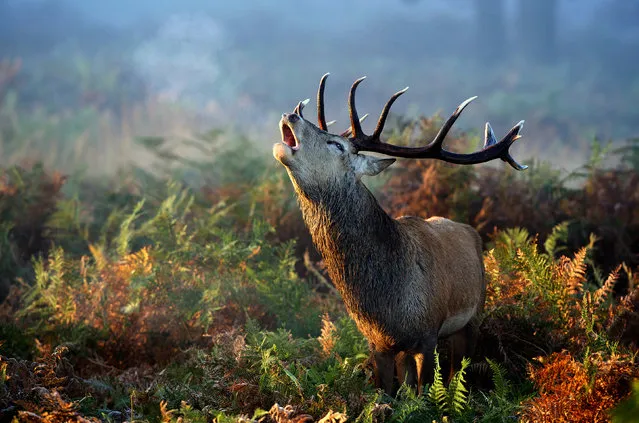
“Autumn Call”. A large red deer stag calling to the hinds in the bracken one misty autumn morning. Photo location: Richmond Park, London, UK. (Photo and caption by Mark Bridger/National Geographic Photo Contest)

“Entering the Inferno”. Forced to find new river crossing points in the Serengeti-Mara region of Eastern Africa, the wildebeest descend into individual despair and collective chaos. Fast currents and steep banks all but deny escape onto the tree-covered banks. New arrivals try unsuccessfully to scramble over the lead group that cannot climb quickly enough onto the available dry ground. Such scenes may become more common as the Great Migration faces more variable climate and narrower corridors from changing land-use. Photo location: Masai Mara, Kenya, Africa. (Photo and caption by Karen Lunney/National Geographic Photo Contest)

“Generations”. A little lion cub watching the zebra with his mother one lazy afternoon. Photo location: Masai Mara, Kenya. (Photo and caption by Mark Bridger/National Geographic Photo Contest)
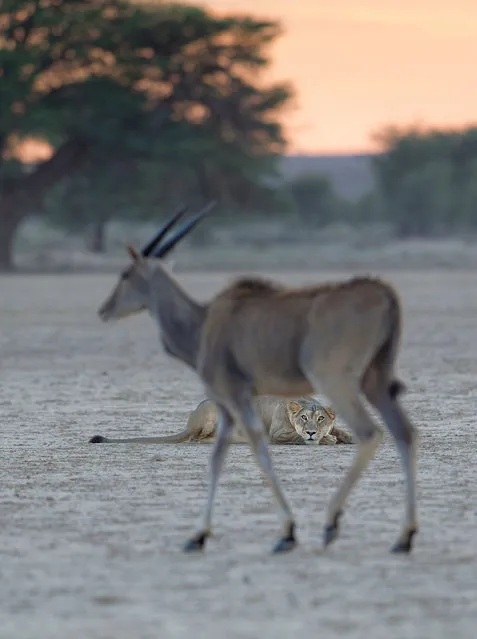
“Eyes on the Prize”. Breathe in. Breathe out. That was the message I was repeating in my head, both to myself and to the lioness in front of me. We had sat with this pride since about 30 minutes prior to sunrise as two totally oblivious adolescent elands strolled closer and closer. This was the deciding moment. This was the tension. I pre-focused on the lioness and waited for the antelope to stroll into my viewfinder. Click. This shot means more to me than the entire sequence I captured afterwards in which it ends pretty badly for the eland. I captured this moment in the Kalahari desert. Photo location: Kgalagadi Transfrontier Park, South Africa-Botswana. (Photo and caption by Morkel Erasmus/National Geographic Photo Contest)
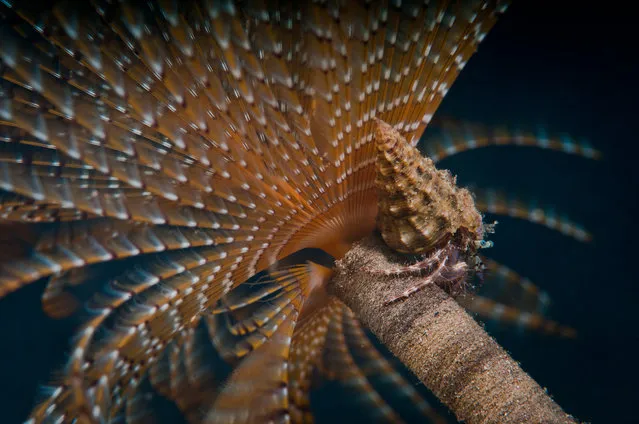
“Where is my food?” The small “Pagurus anachoretus” up the calcareous tube of a type of marine worm (“Sabella spallanzani”), because for it is more easy collect its food, which is transported by the current. It's very diffucult approach to Sabella Spallanzani without it closes quickly. Photo location: Ligurian Sea, Italy. (Photo and caption by Lorenzo Terraneo/National Geographic Photo Contest)
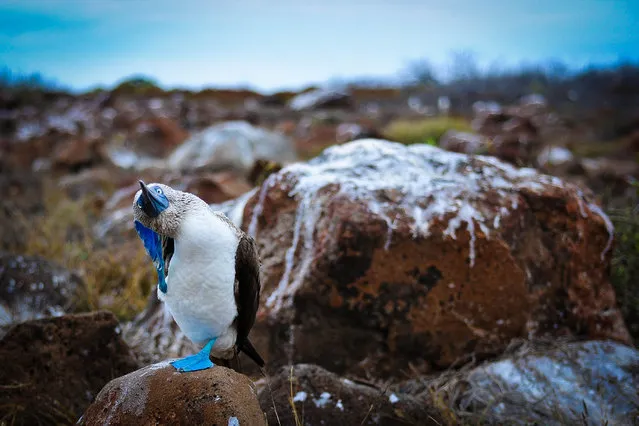
“The Booby Dance!” Blue Footed Boobys are known for their silly mannerisms, including their special dance presented to their mates. While in the Galapagos Islands, I managed to capture the motion of a Booby in action; what a fun looking creature and shot! Photo location: Galapagos Islands. (Photo and caption by Sara Malas/National Geographic Photo Contest)
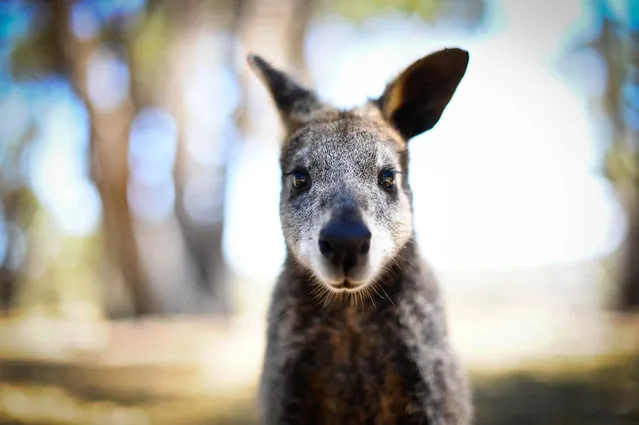
“The Flirt”. The cool thing about this shot was that it was captured by a 50mm lens, which almost gives a human eye view, as there is no zoom. This way, I had the opportunity to encounter a significant level of intimacy with this young Wallaby in Adelaide, Australia. Posing came quite naturally to him, he was quite the flirt! Photo location: Adelaide, Australia. (Photo and caption by Sara Malas/National Geographic Photo Contest)
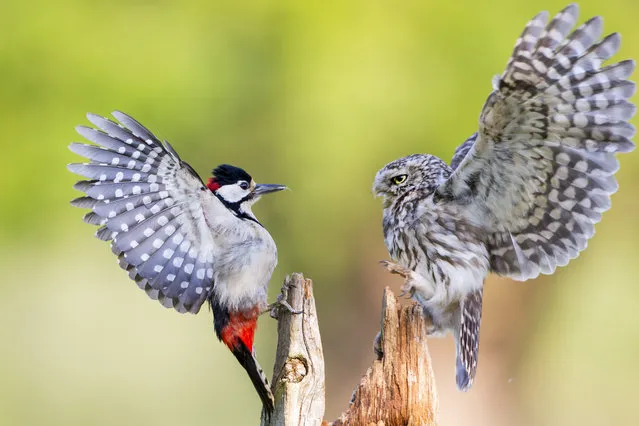
“Stand Off”. A Little Owl (R) defends its feeding position from a Great spotted woodpecker (L) with both birds showing a their full colours with dramatic full wing extensions. Photo location: Droitwich, UK. (Photo and caption by Ian Schofield/National Geographic Photo Contest)
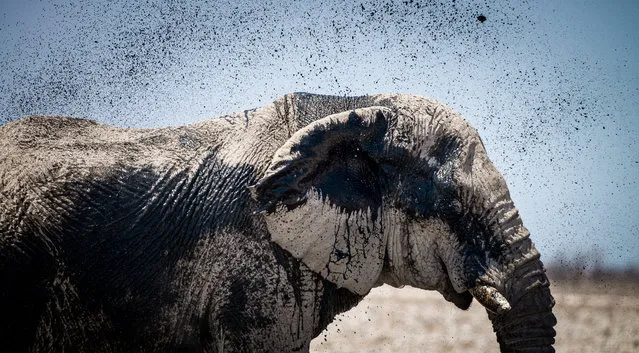
“Body painting”. Elephant spraying water across the body in the Etosha National Park. Photo location: Etosha, Namibia. (Photo and caption by Chris Schmid/National Geographic Photo Contest)
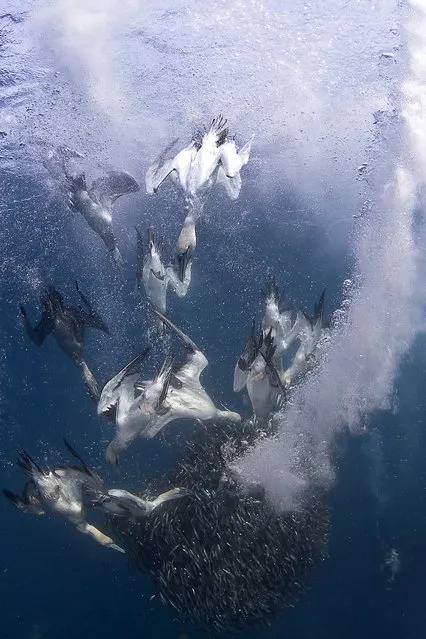
“Gannet Attack”. Cape Gannets diving down to feed on Anchovies that have been driven close to the surface by circling predators of the Wild Coast of the Transkei, South Africa. Photo location: Port St Johns, Wild Coast, Transkei, South Africa. (Photo and caption by Allen Walker/National Geographic Photo Contest)
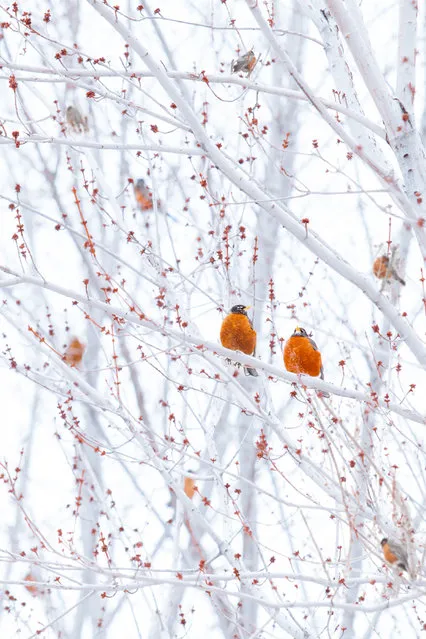
“Waiting for Spring”. Robins gather waiting on a cool March morning in the Black Hills of Dakota. Photo location: Black Hills of South Daktoa. (Photo and caption by Bonny Fleming/National Geographic Photo Contest)
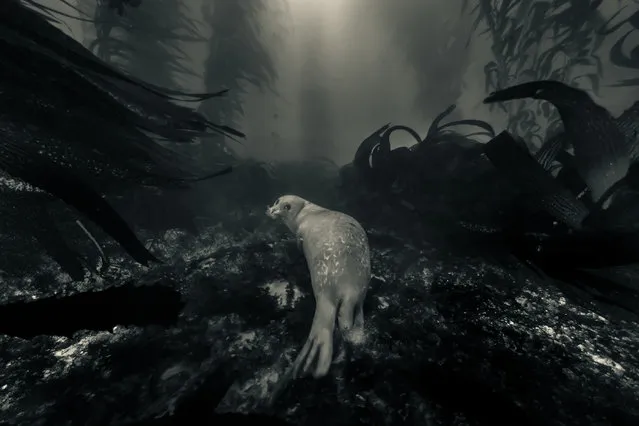
“A Peaceful Place”. A harbor seal rests, if only for a moment, in her mighty kingdom. Photo location: La Jolla, Califonia. (Photo and caption by Ralph Pace/National Geographic Photo Contest)
01 Dec 2013 11:03:00,
post received
0 comments
